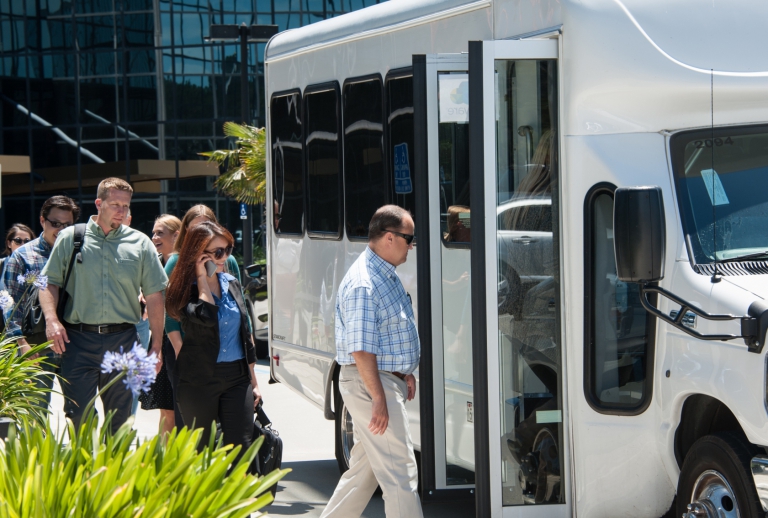20 Recommended Facts For Choosing Employee Transportation Sites
20 Recommended Facts For Choosing Employee Transportation Sites
Blog Article
Top 10 Suggestions To Assist You In Planning And Covering The Routes Of Employee Shuttles
Here are ten top strategies to aid you in planning and arranging your employee shuttle transport.
1. Learn to recognize the needs of employees
Surveys or focus groups are an excellent method of determining where employees live, what shuttle time they prefer, and whether there are any particular needs (such as accessibility or accessibility requirements). This is crucial for designing routes to maximize participation and satisfaction.
2. Analyse Traffic Patterns
Examine the patterns of traffic and peak times in the regions around your company. Google Maps data on traffic can be used to pinpoint congestion-prone routes and avoid these when shuttles are operating. This can reduce delays and ensure a smooth ride.
3. Utilize Technology
Utilize software to design routes that are optimized in light of the real-time information of the traffic patterns and scheduling of employees. Apps for shuttle services allow you to dynamically adjust your routes so you're always able to provide the most efficient service.
4. Establish Strategic Pickup Points
Find central locations in which most people are able to be easily accessed. Look for locations near public transportation centers, residential areas and major intersections for the best coverage without extending the route unnecessarily.
5. Make your schedule flexible
Develop a schedule for shuttles to accommodate varying work hours. Shuttles can be provided at peak times and off-peak hours to accommodate various shifts.
6. Implement a feedback loop
Encourage employees to provide feedback regarding shuttle service. This feedback could be used to alter routes, schedules, or pickup locations. By regularly assessing the satisfaction of employees you can ensure that your service is that is tailored to their requirements.
7. Monitor and analyze Usage Data
Check the utilization of shuttles and determine routes that are popular. Through analyzing the data, you can make better decisions regarding how to distribute resources or enhance the service.
8. Promoting carpooling and ridesharing
Encourage your employees to utilize the shuttle service as well as a carpooling program. This could decrease the number of shuttles required and offer more flexibility. Apps that encourage ridesharing could help in this process and reduce overall costs for transportation.
9. Consider Environmental Impact
Shuttles that are energy efficient could be used to create routes with minimal carbon emissions. Promote the use of hybrid or electric vehicles for the shuttle service. This not only aids in achieve sustainability, but also has an impact on your employees who are enthused by eco-friendly practices.
10. Check for Safety and Compliance
You must ensure that you comply with all safety and legal regulations. It is important to perform regular vehicle inspections, verify that drivers are trained and certified, and provide insurance protection. Safety of passengers must always be considered when planning your travel plans.
These methods will enable you to develop an employee shuttle system which are efficient and efficient. This will also ensure the safety of employees and maximize utilization of resources. Check out the top rated employee transportation tips for more examples including airport shuttle to airport, private car service, atlanta airport transportation, cheapest transport, bus shuttle service, transport to the airport, airport shuttle airport, shuttle service near me, shuttle to airport atlanta, book a shuttle and more.
10 Top Tips For Safety And Reliability For Corporate Event Transportation
Here are 10 of the best security tips and reliable services for events at corporate levels:
1. Do a thorough inspection of your vehicle
Prior to the event, make sure that all vehicles used for transportation undergo a thorough inspection. To ensure that crucial elements like brakes, tires pressure seats, lights, and seatbelts are operating properly, test them. Regular inspections and maintenance prior to departure can help reduce the chance of mechanical breakdowns.
2. Employ qualified and experienced drivers
Verify that all drivers hold an active copyright, are licensed properly and have a clean driving record. Verify their backgrounds and ensure that they've been in the business of transporting large groups, especially for corporate events. To ensure safety and security it is essential to hire drivers who are trained and have previous experience.
3. Safety Training Programs
Safety training should be provided to all employees and drivers at the transportation company. The training should include defensive driving, emergency procedures and customer care techniques. Regularly scheduled training sessions will help in ensuring safety and preparing drivers for any scenario that might be encountered.
4. Establish Clear Emergency Protocols
Create and communicate clear procedures for emergencies to drivers and passengers. It includes procedures for medical emergencies, accidents, and other unexpected scenarios. To ensure safety overall make sure that you conduct exercises to ensure everyone knows how to react in an emergency.
5. GPS Tracking Software and Fleet Management Software
Install GPS tracking on all vehicles to monitor them in real-time. This technology enables transportation managers to optimize routes, track shuttles, and respond quickly to any problems. Software for managing fleets will help monitor the performance of vehicles as well as the maintenance requirements.
6. Assure Adequate Coverage
Review and ensure that you have a comprehensive insurance policy for all transportation-related activities. This includes liability insurance as well as coverage for accidents or injuries that might occur during transportation. The company and its attendees are insured adequately, which provides peace ofmind.
7. Be sure to communicate clearly with your attendees.
Details about transportation must be communicated clearly to attendees. This includes pickup places and times as well as contact information for coordinators. By distributing these details to attendees in advance it will ease their expectations, and also give them confidence in the arrangements for transportation.
8. Check the weather and traffic conditions.
On the day of the event, you must be aware of traffic conditions and weather. Be prepared to adjust routes or schedules if needed to ensure punctual arrivals. An approach to dealing with severe weather or traffic can improve the reliability of transport services.
9. Get Comments and conduct Post-Event Reviews
When the event is finished, you should collect feedback from the attendees about their transportation experience. Ask for feedback from guests about safety, punctuality, and general satisfaction. The feedback you get can help identify potential areas of improvement, and help ensure that the future transport meets safety and reliability requirements.
10. Create a Contingency Plan
Create a contingency plan for unexpected events, such as car breakdowns or absences of drivers. The plan should contain alternative transportation options and procedures to be followed in the case of an emergency. The contingency plans will increase the reliability of your event, so that attendees will not be stranded.
These suggestions can help companies enhance the safety and reliability of their corporate event transportation services. The importance of safety is not just helpful to guests but also the entire organization. A reliable transportation system is essential for the success for corporate events. It ensures that attendees enjoy an enjoyable experience. Check out the most popular event transportation for site tips including transport systems, specialized transportation inc, globe transport, coach transportation, managed logistics, transportation and logistics services, transporters near me, transportation and logistics services, transportation management system, transportation companies and more.